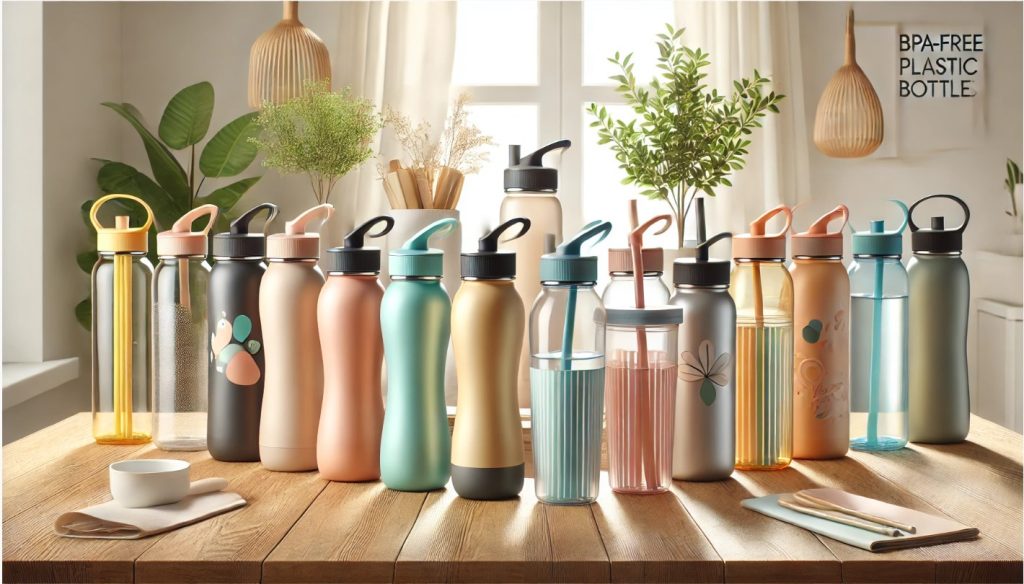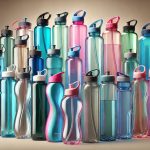Understanding BPA and Its Health Implications
Bisphenol A, commonly referred to as BPA, is an industrial chemical that has been used in the manufacturing of certain plastics and resins for decades. It primarily appears in polycarbonate plastics and epoxy resins, which were once widely utilized in food and beverage containers, including water bottles. Over time, research raised concerns about the safety of BPA due to its potential ability to mimic the hormone estrogen in the human body. Although the degree of risk is still debated, many consumers today prefer to err on the side of caution and choose products that do not contain BPA.
BPA gained widespread attention as questions emerged about whether its presence could contribute to developmental and reproductive issues, behavioral problems, and other health concerns. Regulatory bodies in various countries have responded by placing restrictions on BPA usage in items like baby bottles and sippy cups. These moves helped spark a broader consumer shift toward BPA-free products as individuals became more conscious of their own health and that of their families.
The rise in BPA-free plastic bottles is not simply a passing trend. It reflects a growing awareness of what we ingest and how everyday materials interact with our bodies. As knowledge deepens, people seek safer products, encouraging manufacturers to develop new materials and processes that minimize or eliminate potentially harmful chemicals.
Why Choose BPA-Free?
Prioritizing Health
For many, the key reason to opt for BPA-free plastic bottles is peace of mind. By eliminating BPA, consumers reduce the likelihood of exposure to a chemical that may disrupt the body’s hormonal balance. While regulatory agencies maintain that current levels of BPA exposure through food and drink containers are generally safe, sensitive groups such as infants, children, and pregnant individuals may still prefer to avoid even minimal risks.
Choosing BPA-free bottles can be viewed as a preventive measure. With our modern lives already filled with chemical exposures from various sources, switching to a BPA-free alternative helps ensure that the water or beverages we consume come from containers that are less likely to leach questionable substances into the contents.
Promoting a Safe Lifestyle
BPA-free plastic bottles are part of a broader lifestyle choice aligned with wellness, sustainability, and informed consumerism. Individuals who pay attention to product labels, study ingredient lists, and consider the environmental impact of their purchases often gravitate toward BPA-free options. This decision complements other healthy habits, such as choosing organic produce or avoiding synthetic additives in food. The bottle you carry daily can become a simple yet influential component of a healthier, more conscientious life.
Common Materials in BPA-Free Bottles
BPA-free plastic bottles come in a variety of materials that provide durability, convenience, and safety. Understanding these materials can help you make informed decisions when selecting a bottle.
Tritan
Tritan is a popular material used in many BPA-free plastic bottles today. It is known for its durability, clarity, and resistance to shattering. Unlike older polycarbonates, Tritan does not contain BPA or other bisphenols, making it a trusted choice for many consumers. Tritan bottles remain clear and resistant to odors even after numerous uses and washes, making them a dependable option for both adults and children.
Polypropylene
Polypropylene is another type of plastic commonly used in BPA-free bottles. It has a slightly more opaque appearance than Tritan but still offers excellent durability. Polypropylene bottles tend to be lightweight, affordable, and resistant to heat, allowing for repeated use over time without significant wear. They are often favored by those who prefer a more budget-friendly option that is still safe and reliable.
PET (Polyethylene Terephthalate)
PET is widely used for single-use beverage bottles, but BPA-free variations are now common for reusable bottles as well. PET is known for being lightweight and transparent, providing a clean and crisp look. Although PET bottles are not usually intended for long-term use, some BPA-free versions are designed for repeated refilling and can be suitable for those who value convenience and cost-effectiveness.
HDPE (High-Density Polyethylene)
HDPE is a more opaque plastic often used in milk jugs and certain reusable bottles. BPA-free HDPE is recognized for its toughness and resistance to chemicals. While it may not offer the same aesthetic clarity as Tritan, it excels in ruggedness, making it an excellent choice for outdoor enthusiasts, campers, and athletes who need a bottle that can withstand tough conditions.
Key Features and Qualities of BPA-Free Bottles
Durability and Longevity
One of the most appealing aspects of BPA-free plastic bottles is their resilience. High-quality BPA-free plastics resist cracking, shattering, and deformation over time, ensuring that you do not have to frequently replace your bottle. This durability is particularly important for active individuals, travelers, and children who may drop or bump their bottles against various surfaces.
Lightweight Convenience
BPA-free plastic bottles typically weigh less than alternatives like glass or stainless steel. Their lightweight nature makes them easy to carry throughout the day, whether you are hiking in the wilderness, commuting to work, or simply running errands around town. Their portability contributes to maintaining consistent hydration habits because you are more likely to bring your bottle along when it does not add noticeable weight to your bag.
Ease of Use
Many BPA-free plastic bottles are designed with user-friendliness in mind. Features such as ergonomic grips, easy-open lids, and convenient carrying loops enhance their overall utility. Some are even designed to fit into standard cup holders, bike bottle cages, or backpack pockets. Additionally, the clarity of certain BPA-free plastics allows you to easily see how much liquid you have left, so you can track your intake more effectively.
Versatile Applications
BPA-free plastic bottles are not limited to carrying just water. They can be used for a wide range of beverages, including sports drinks, infused waters, iced teas, and even smoothies. Many are designed to handle both cold and hot liquids, giving you the flexibility to use a single bottle for multiple purposes. This versatility reduces the need to purchase multiple specialized containers.
How to Identify BPA-Free Plastic Bottles
Checking Product Labels
The simplest way to determine if a bottle is BPA-free is by checking its labeling. Many reputable brands prominently highlight that their products are BPA-free. This information can be found on the bottle itself, on tags attached to it, or on the manufacturer’s packaging. Being transparent about BPA-free status is now considered a selling point, making it easy for consumers to identify safer options.
Resin Identification Codes
Plastic products typically feature a resin identification code at the bottom, indicated by a number inside a triangle of arrows. Traditional polycarbonate plastics containing BPA often carry the number 7. However, not all plastics marked with 7 contain BPA, since 7 is a catch-all category for “other” plastics that are not part of categories 1 through 6. When looking at resin codes, it is best to also rely on manufacturer claims or seek products from trusted brands known for BPA-free materials.
Trusted Brands and Certifications
Well-established brands that have openly committed to avoiding BPA can offer added reassurance. Some organizations and certification bodies test products for safety and quality, granting certifications that indicate the product has met certain standards. While you may not see these certifications on every BPA-free bottle, their presence can be an extra layer of confidence in your choice.
Pros and Cons of BPA-Free Plastics
Advantages of BPA-Free Bottles
BPA-free plastic bottles provide numerous benefits. They allow consumers to steer clear of a potentially harmful chemical, supporting a healthier lifestyle. Because BPA-free plastics often remain durable and relatively inexpensive, these bottles make an accessible option for the average person. Their lightweight nature and versatility mean they serve a variety of needs, whether for a child’s school day or an athlete’s training session.
BPA-free bottles also address the concerns of eco-conscious consumers. While they are not perfect from an environmental standpoint, using a reusable BPA-free bottle reduces the number of single-use containers that end up in landfills. By choosing a BPA-free bottle and reusing it regularly, you can reduce your environmental footprint over time.
Potential Drawbacks to Consider
Despite their advantages, BPA-free plastic bottles are not without potential downsides. They may still contain other chemicals that are not as well-studied, and research on the safety of alternative plastics is an ongoing process. Some consumers prefer materials with longer histories of safety, like glass or stainless steel, to fully avoid unknown risks associated with newer plastic formulations.
Durability and scratch resistance, while generally good, vary by brand and material type. Cheaper BPA-free bottles may scratch or become clouded over time, potentially harboring bacteria and affecting the taste of your beverages. While high-quality bottles address these issues more effectively, cost can be a factor.
Care, Maintenance, and Longevity of BPA-Free Bottles
Proper Cleaning Techniques
Caring for a BPA-free plastic bottle involves routine cleaning to ensure it remains hygienic and long-lasting. Warm, soapy water is often sufficient for day-to-day cleaning, and a bottle brush can help you reach inside narrow openings. Rinsing thoroughly after use, particularly if you have stored flavored or sugary beverages, can prevent lingering odors or residues.
For deeper cleaning, especially if you notice any lingering smells, you can soak the bottle in a solution of water and mild vinegar. Allow it to sit for several hours, then rinse it thoroughly. Some BPA-free bottles are also dishwasher-safe, but always check the manufacturer’s recommendations before placing your bottle in the dishwasher.
Avoiding High Heat and Sun Exposure
Prolonged exposure to high heat, such as leaving your bottle in a hot car, can lead to warping or degradation of the plastic. While BPA-free bottles are more stable than older plastics, extreme temperatures may still affect their structural integrity over time. Similarly, direct and prolonged sun exposure can cause discoloration and potentially weaken the material. Storing your bottle in a cool, shaded area when not in use helps maintain its condition.
Inspecting for Wear and Tear
Over months or years of use, you may notice signs of wear in your BPA-free plastic bottle. Scratches inside the bottle can create tiny crevices for bacteria to grow. If you observe cracks, deep scratches, or persistent odors that cleaning does not remove, it may be time to replace the bottle. Regularly inspecting your bottle ensures that you maintain a safe and pleasant drinking experience.
Extending the Bottle’s Life
By treating your BPA-free bottle with care, you can extend its lifespan. Avoid dropping it from significant heights. When transporting it in a bag, consider using protective sleeves or pouches. Minimizing contact with abrasive surfaces and cleaning it gently will also help keep the interior smooth, reducing the likelihood of residues and microbes getting trapped.
Environmental Considerations
Reducing Single-Use Plastics
One of the advantages of BPA-free plastic bottles is the potential to reduce reliance on single-use plastics. By investing in a reusable bottle, you cut down on disposable cups and bottles that accumulate in landfills. This habit not only saves money over the long term but also helps preserve natural resources and reduces pollution associated with manufacturing and disposing of single-use plastics.
Recycling and End-of-Life
While BPA-free plastic bottles are more sustainable than their single-use counterparts, they are still made from plastic. At the end of a bottle’s life, recycling is an important consideration. Many BPA-free plastics, such as certain Tritan blends, are recyclable in facilities that handle category 7 plastics, but availability varies by region. Check with local recycling guidelines to ensure proper disposal. Proper recycling prevents these plastics from contributing to environmental degradation.
Balancing Material Choices
BPA-free plastic bottles offer a middle ground for those who want to avoid certain chemicals but still appreciate the convenience and affordability of plastic. Though stainless steel and glass may be more environmentally benign over time due to their recyclability and chemical stability, they can be heavier or more expensive. Choosing BPA-free plastic represents a pragmatic choice that balances personal health concerns, budgetary considerations, and environmental responsibility.
Comparing BPA-Free Plastic to Other Materials
BPA-Free Plastic vs. Glass
Glass bottles are lauded for their purity and lack of chemical leaching. Unlike plastic, glass is an inert material that does not absorb odors or flavors. It is also fully recyclable and can be recycled endlessly without degrading quality. However, glass bottles are heavier and more fragile, making them less practical for certain activities or for children’s use. BPA-free plastic, while not as pure as glass, offers a lighter, more durable, and less breakable alternative that suits active lifestyles.
BPA-Free Plastic vs. Stainless Steel
Stainless steel bottles are another popular alternative, often favored for their durability, longevity, and minimal chemical concerns. Stainless steel is not prone to leaching harmful substances, and many brands use food-grade or medical-grade steel. However, stainless steel can sometimes impart a metallic taste to beverages, and these bottles tend to be more expensive and heavier than their BPA-free plastic counterparts. BPA-free plastic offers an affordable and lightweight solution, though it may not be as robust or taste-neutral as high-quality steel.
BPA-Free Plastic vs. Aluminum
Aluminum bottles often have a protective lining to prevent direct contact between the metal and the beverage. These linings must be free of BPA to avoid defeats in their purpose. Although aluminum is lightweight and durable, concerns arise if the lining becomes damaged, potentially allowing contact with metal or other chemicals. BPA-free plastic bottles are simpler in that they do not rely on a lining, but they may not match aluminum’s longevity or heat resistance. Each material has trade-offs, and your choice ultimately depends on priorities like weight, taste neutrality, cost, and potential health effects.
Common Myths and Misconceptions
BPA-Free Means Chemical-Free
One of the most common misconceptions is that BPA-free automatically means the bottle contains no chemicals at all. In reality, all plastics are made from chemical compounds. BPA-free signifies that one particular chemical—BPA—is not present. Manufacturers have replaced BPA with other substances that they deem safer, but ongoing research continues to evaluate these alternatives. While BPA-free is generally considered a safer choice, it does not mean the bottle is entirely free of synthetic chemicals.
BPA-Free Bottles Are Automatically Healthier
Although selecting a BPA-free bottle is a step in a healthier direction, it is not a guarantee of perfect health. Overall well-being depends on many factors, including diet, exercise, genetics, and lifestyle choices. BPA-free bottles can support a healthier routine by ensuring you are not unnecessarily exposed to BPA, but they should be just one piece of a more holistic approach to health and wellness.
All BPA-Free Plastics Perform the Same
BPA-free is a broad category, and not all BPA-free plastics are created equal. Quality varies widely among brands. Some use highly researched and tested materials like Tritan, while others use less proven formulations. Additionally, the design, manufacturing processes, and quality control measures differ from brand to brand. Thoroughly researching a brand, reading product descriptions, and looking at customer reviews can help you find a high-quality BPA-free bottle that meets your needs.
Making an Informed Decision
Considering Your Lifestyle
Choosing the right BPA-free plastic bottle often begins with considering your daily routines and activities. If you spend much of your time outdoors or traveling, a lightweight and durable Tritan or polypropylene bottle might be ideal. If you frequently carry hot beverages, look for BPA-free bottles designed for temperature resistance. If aesthetics and clarity matter, focus on products that maintain transparency and resist staining.
Thinking about how and where you will use your bottle can guide you toward the features that matter most. A bottle designed for an athlete may differ from one intended for office use or for carrying to a child’s classroom. Defining your priorities before shopping can help narrow down your options.
Evaluating Product Features
In addition to the base material, consider features that improve the overall experience. Look for leak-proof lids that prevent spills, handles or loops for easy carrying, and wide-mouth openings for simple cleaning or adding ice cubes. Some BPA-free bottles include built-in filters, infusers, or measurement marks that help track your hydration goals. Matching product features to your personal habits ensures that you choose a bottle you will enjoy using daily.
Balancing Cost and Quality
BPA-free plastic bottles come in a wide price range. Cheaper options might work for short-term use or backup bottles, while investing in a slightly higher-quality bottle can pay off in the long run. A durable, well-made BPA-free bottle is less likely to break, leak, or become clouded, meaning you will not need frequent replacements. This approach can save money over time and provide a more satisfying user experience.
Keep in mind that a higher price tag does not always guarantee quality. Reading reviews, examining the brand’s reputation, and evaluating the warranty or return policy can help ensure that you get the best value for your budget. Ultimately, consider investing in a trusted brand known for consistent quality and transparent materials.
Assessing Environmental and Health Trade-Offs
For some consumers, selecting a BPA-free plastic bottle involves balancing multiple concerns: the health of their family, the long-term environmental impact, and practical considerations like weight and cost. While BPA-free bottles provide a healthier choice than older plastics containing BPA, they are not entirely free from environmental impacts. If sustainability is a top priority, you might consider also owning a stainless steel or glass bottle for certain occasions. Many people find that keeping multiple bottle types allows them to adapt to different situations without compromising their values.
Future Trends and Improvements
As research continues and consumer awareness grows, BPA-free plastic bottles will likely see further improvements. Manufacturers are exploring new materials, better recycling processes, and more transparent labeling to address lingering concerns. By staying informed about new developments, you can make even more educated choices when it comes time to replace your bottle or expand your collection.
Conclusion
BPA-free plastic bottles have become a prominent part of modern consumer culture, reflecting the growing importance of health, environmental consciousness, and personal preferences. By understanding the concerns surrounding BPA and learning about the wide range of BPA-free materials now available, you can confidently choose a bottle that meets your needs.
These bottles offer a balance between the reassuring absence of BPA and the convenience of lightweight, durable plastics. They often come with user-friendly features, suit various lifestyles, and help cut down on single-use plastics, all while staying cost-effective.
While no single material is perfect, BPA-free plastic bottles represent a practical and widely accessible step toward healthier, more sustainable living. By examining brands, reading labels, and considering your individual needs, you can find a BPA-free bottle that not only aligns with your values but also enhances your daily routines. As you continue to explore healthier and more eco-friendly options, remember that every thoughtful choice contributes to a more informed, conscientious way of life.







